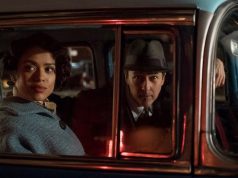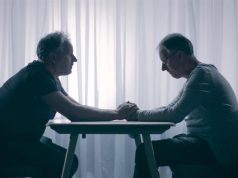Michael Moore’s approach in his new documentary “Bowling for Columbine” is that of an investigative journalist, right down to being snarky and badly dressed.
His subject matter is guns in America, but he doesn’t start out with a particular point to prove, other than what we already know: Too many people in this country are killed by guns. The film is a record of his attempt to find answers. He methodically tries one line of thought, which leads to new ways of thinking, and he tries those, too. We see the whole process. If Moore were writing a thesis paper, this extraordinary film would serve as his research notes.
Moore’s politics do come through, but they’re balanced. He grew up in hunting-happy Michigan and is a member of the NRA, but doesn’t seem opposed to the idea of reasonable gun control. Mostly, he is perplexed: Canada has 7 million guns in 10 million homes — a very high per-capita rate of gun ownership — yet only a couple hundred gun-related deaths per year. In the United States, there are 11,000 gun deaths every year. What is so different about America that makes us kill each other?
And so “Bowling for Columbine,” while focusing on guns, really comes to be about fear. People are afraid of their cities, afraid of people who have guns, afraid not to have guns themselves. Moore explores possible causes like racial tension, violent music and the media, occasionally with humor, often with brash, ambush-journalism techniques, always with an unquenchable curiosity.
We meet Oklahoma City bomber Terry Nichols’ brother James, who was briefly a suspect, too. James Nichols is clearly an arms fanatic, and a stereotpyical one, railing against the “guvment”; he is probably even an embarrassment to the NRA. At the other end of the spectrum, we meet an alarmingly lucid and thoughtful Marilyn Manson, whose music was blamed for the Columbine shootings.
Somewhere in the middle of that spectrum, Moore actually nails an interview with NRA president Charlton Heston. (He does it by walking up to Heston’s house, ringing the bell, and requesting an interview.) The NRA held a convention in Denver just 10 days after Columbine, and made another stop in Flint, Mich., just after a 6-year-old girl there had the distinction of becoming the youngest school-shooting victim in American history. Moore asks Heston about these moves; the entire interview is riveting and squirm-inducing.
There is also a moving sequence in which Moore takes two Columbine survivors to K-Mart headquarters, to protest the chain’s selling of the 17-cent bullets that almost killed them and that still reside in their bodies.
Moore’s work as a documentarian is impressive. There is a sequence in which we see footage from the Columbine surveillance cameras during the attack, accompanied by 911 recordings. There is no other narration. Moore lets the words and images speak for themselves. The impact is startling. Three-and-a-half years later, and even after another, more destructive national tragedy, Columbine is still a vivid, horrific nightmare in the national consciousness.
Someone observes that when kids can get guns and commit that sort of mass murder, something is clearly wrong. The question, then, is what that something is. Just having the guns apparently doesn’t lead to wanton killing; look at Canada.
I said “Bowling for Columbine” is a record of Moore’s attempt to find answers. What’s scary is that there don’t seem to be any. As a documentary of a man’s search for clarity, and regardless of one’s own politics, “Bowling for Columbine” is a powerful piece of work.
A (2 hrs., 2 min.; )





